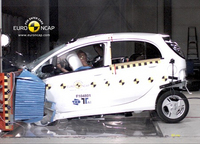Euro NCAP Now Testing Plug-in Electric Vehicles - VIDEO ENHANCED
Euro NCAP today publishes the results of seven new vehicles, including its first test of a fully electric car, marking the start of a series of EV tests in 2011
BRUSSELS - February 23, 2011: Euro NCAP is announcing the outcome of its first assessment of an electric plug-in vehicle, the Mitsubishi i-MiEV. The car’s creditable four star rating shows that safety does not need to be compromised in zero-emissions vehicles. The i-MiEV shares its rating with its twin models, the Citroën C-Zero and Peugeot iOn, which have the same design and safety equipment.
Dr Michiel van Ratingen, Euro NCAP’s Secretary General says: “We recognize the efforts done by Mitsubishi to demonstrate that plug-in battery powered cars can be as safe as others. It shows that a future 5 star accolade for EVs is not unthinkable. Whether produced by established car manufacturers or by new players on the market, consumers should expect to get electric vehicles that meet the same safety standards as conventional vehicles."
Click PLAY to watch the crash test video
Euro NCAP tests plug-in vehicles with live batteries and the cars are exposed to the same test conditions as the other cars in the programme. Special attention is given to post-crash battery integrity and the proper functioning of the battery cut-off switch that isolates the high-voltage battery in the event of a crash. In order to test these cars in a safe manner, extra precautions are taken before, during and after testing: the tests can only be performed at laboratories with specially-trained personnel; service plugs are removed during vehicle preparation and extra fire-fighting measures are taken to ensure the safety of laboratory personnel and equipment. No electrical or fire hazards were detected during the testing of the i-MiEV.
Also released this month is the small off-road 4x4 Dacia Duster which, with an overall rating of 3 stars, failed to impress Euro NCAP. Scoring only 28% in pedestrian protection and 29% for safety assist, the Duster performs well below the latest level of safety performance demonstrated by other new cars on the European market. It is disappointing that a mother company like Renault does not give safety the same priority in Dacia cars as it does in cars sold under its own brand. In contrast, the Mitsubishi ASX and the Nissan Juke achieved the coveted 5 star overall rating. Furthermore, Euro NCAP applied 5 stars to the small MPV Hyundai ix20, twin of the KIA Venga tested in 2010. Both cars have the identical safety equipments and interior fittings and are expected to perform identically.
Euro NCAP is revealing the first Euro NCAP Advanced reward of 2011. The Infiniti’s Lane Departure Prevention (LDP) system, available on the Infinity FX tested in 2009, is a camera-based technology helping drivers return the vehicle to its travelling lane when an unintentional lane departure is likely. Dr Michiel van Ratingen says: “Lane departure is a factor in a large proportion of accidents, often involving loss of control and resulting in fatal and serious injuries. Infinity’s LDP system helps the driver to avoid this potential hazard. It is another example of industry’s latest efforts to further reduce accidents and casualties on the roads’. Euro NCAP will hand out the Euro NCAP Advanced reward on the Infiniti’s booth at the Geneva Motor show on March 1st.
Detailed information on the latest results and on the safety of the rewarded technology can now be found on www.euroncap.com.
About Euro NCAP
Euro NCAP provides motoring consumers with a realistic and independent
assessment of the safety performance of some of the most popular cars
sold in Europe.
Established in 1997 and now backed by seven European Governments, the European Commission and motoring and consumer organizations in every EU country, Euro NCAP has rapidly become a catalyst for encouraging significant safety improvements to new car design.



